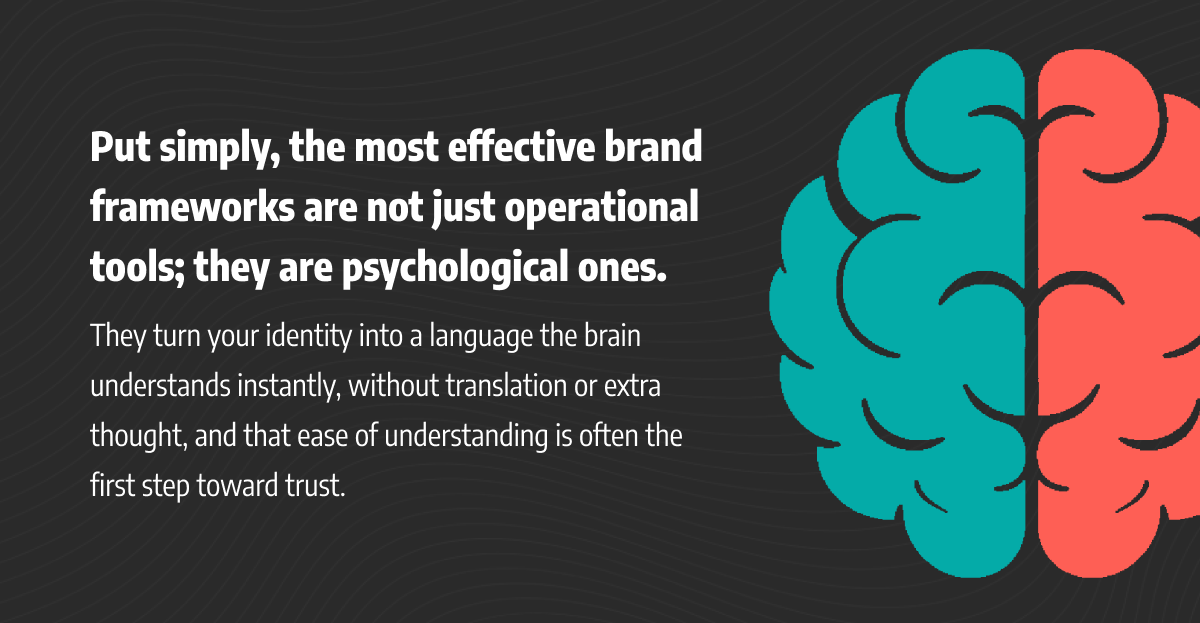
Most brands know they should be consistent, using the same colors, tone of voice, and overall style across every touchpoint. But few stop to ask: why does consistency actually matter? What’s happening in the mind of the person on the other side of the screen or ad?
For me, this question sits at the intersection of two long-standing interests: psychology and brands. Before I ever worked in creative strategy, I was fascinated by psychology—especially how people form patterns of trust, recognition, and belonging. Over time, I’ve realized that the same cognitive processes that help people make sense of the world also explain why some brands feel instantly recognizable and trustworthy while others feel disjointed or forgettable.
A brand framework, at its core, isn’t just a marketing tool. It’s a reflection of how humans think. It provides structure and predictability, the very things our brains crave when we process information, evaluate choices, and decide who to trust. In this post, we’ll explore that connection through three psychological principles—processing fluency, familiarity, and trust—and show how each one shapes the way audiences experience your brand.
1. Ease of Processing (Processing Fluency)
One of the most reliable findings in cognitive and consumer psychology is that when a stimulus, such as a logo, tagline, or message, is easy for the brain to process, people tend to like it more, trust it more, and believe it more quickly. That sense of ease is called processing fluency (Schwarz et al., 2023, Metacognitive experiences as information: Processing fluency in consumer judgment and decision making).
Fluency is essentially a mental shortcut. When something looks or sounds clear, our brains interpret that clarity as a signal of truth and familiarity. We feel safer engaging with it. For brands, that means the structure and consistency of your identity have direct cognitive consequences. Simpler logos, clearer hierarchies, and predictable visual patterns reduce what psychologists call “processing load,” the mental effort required to make sense of what you are seeing.
Research has repeatedly shown that when design elements are cohesive and repeated, people perceive the brand more favorably. In one study, repeated exposure to a low-complexity logo increased both fluency and positive judgment of the brand (Reber et al., 2008, Effects of Brand Logo Complexity, Repetition, and Spacing on Processing Fluency and Judgment). Conversely, when a brand’s visuals, typography, or messaging style feel inconsistent, the audience experiences what cognitive scientists call disfluency, a moment of hesitation where the brain pauses to reconcile conflicting information (Kim & Kim, 2020, The Effects of Processing Fluency in Prosocial Campaigns: Effort for Self-Benefit Produces Unpleasant Feelings).
This is where a strong brand framework becomes more than a set of aesthetic rules. It is, in effect, a cognitive design system. A well-constructed framework ensures that every piece of communication reinforces a shared visual and verbal rhythm, a rhythm the brain can learn, store, and recall with minimal effort. The more consistently those cues appear, the more fluent the brand becomes in the minds of its audience.
Internally, the same logic applies. When your designers, writers, and marketers operate within a defined framework, they eliminate creative guesswork. That means fewer disjointed interpretations and a smoother, more predictable brand experience for customers. In both cases, the goal is the same: reduce friction, both in how your teams create and in how your audiences perceive.
Put simply, the most effective brand frameworks are not just operational tools; they are psychological ones. They turn your identity into a language the brain understands instantly, without translation or extra thought, and that ease of understanding is often the first step toward trust.

2. Familiarity, Repetition, and Certainty
Once a brand achieves fluency, the next psychological mechanism takes hold: familiarity. The mere-exposure effect tells us that people tend to develop a preference for things they see more often, as long as those things remain consistent. Repeated exposure builds comfort, and comfort builds trust.
A recent article in The Branding Journal summarized this dynamic well: “A familiar brand feels safe and reliable, reducing uncertainty, building trust, and strengthening emotional connections” (The Overlooked Power of Brand Familiarity: Psychological Factors and Hidden Benefits, 2025). Other studies have reinforced this connection, showing that brand familiarity directly influences attachment and trust, particularly when supported by consistent experiences across time and channels (Pérez et al., 2021, Brand Familiarity and Brand Experience on Brand Attachment).
The psychology is straightforward: when the brain recognizes a pattern, it perceives safety. In evolutionary terms, familiar stimuli signal “known” rather than “threat.” The same logic applies to brands. Every time a customer sees your logo, hears your tone of voice, or experiences your product in a consistent way, their brain files that interaction into the same mental folder. Over time, those cues create a sense of certainty, and that certainty becomes emotional security.
A well-built brand framework is what allows this process to happen. It ensures that the patterns audiences encounter are deliberate and recognizable. Visual and verbal elements are designed to repeat just enough to become comforting without feeling stale. That balance—consistency with subtle evolution—is what keeps familiarity alive while allowing creativity to thrive.
Inside organizations, this same principle prevents fragmentation. When internal teams follow a unified framework, every department communicates within the same set of recognizable boundaries. Marketing doesn’t sound different from operations. Sales doesn’t pitch a different story than the website. The entire organization begins to “speak the same language,” reinforcing familiarity from the inside out.
Inconsistency, by contrast, introduces cognitive friction. It forces the brain to question whether it is seeing the same brand or a new one. And in a market full of competing signals, uncertainty is rarely a winning strategy.
3. Trust, Decision Efficiency, and Loyalty
When fluency and familiarity align, the final layer of brand psychology emerges: trust. Trust is not built from big gestures alone; it accumulates through a long sequence of consistent, reliable experiences. In psychological terms, trust reduces perceived risk and simplifies decision-making.
Studies across multiple industries have demonstrated that consistency plays a central role in building trust. In one study of smartphone brands, positive brand experiences led to increased brand trust, which in turn strengthened attitudinal loyalty (Chinomona, 2023, Frontiers in Psychology). Similarly, research into sustainable brands found that perceived trust was the critical variable in maintaining long-term consumer relationships (Cao et al., 2025, Journal of Cleaner Production).
That connection has measurable business implications. According to the Yale School of Management, 67 percent of consumers say they must trust a brand before continuing to buy its products (Navigating Brand Trust in Modern Marketing, 2023). In other words, trust is not a soft metric; it is a driver of revenue and retention.
A clear and disciplined brand framework is what allows trust to form and compound. When your messaging, design, and behavior stay consistent across time and context, you create a sense of dependability. Customers learn that your brand will behave in predictable ways. Predictability reduces uncertainty, and reduced uncertainty encourages action.
Internally, the benefits are just as tangible. Teams that operate within a shared framework make faster, more confident decisions. They spend less time debating subjective preferences and more time producing aligned work. That decision efficiency mirrors what happens externally for your audience: the brand becomes easier to trust because it is easier to understand.
Over time, this alignment turns trust into loyalty. Customers stop re-evaluating whether they believe in your brand because their experiences continue to confirm it. That is the psychological endgame of a well-built brand framework: not just recognition, but enduring confidence.
4. Building Frameworks That Work With the Brain
If brand frameworks work because they mirror how the mind processes information, then building one requires both strategic precision and psychological empathy. The goal is not to constrain creativity but to design systems that help people—both inside and outside your organization—feel clarity, ease, and confidence.
Start by defining the cues that make your brand recognizable. These could be visual elements like logo treatments and color palettes, or verbal ones like tone, pacing, and point of view. The key is to repeat these cues consistently enough that the brain learns them.
Next, map the relationships among your sub-brands, services, or products. Strong frameworks make it clear how each component connects to the parent brand so that trust and familiarity transfer naturally between them.
Audit your current brand ecosystem for consistency. Where do tone, visuals, or experience break down? Those gaps are often invisible internally but highly visible to audiences.
Just as important, empower non-marketers to apply the framework effectively. Create quick reference tools or decision guides that make alignment easy. A framework that only lives in a design folder is not a framework—it’s a missed opportunity for behavioral coherence.
Finally, measure how your framework is performing. Track brand recall, trust indicators, or even internal efficiency metrics like reduced design revisions or faster campaign approvals. These measurements help translate psychological clarity into business impact.
Conclusion
At its heart, a brand framework does more than keep your colors and fonts in line. It reflects how people process, remember, and trust the world around them. When built thoughtfully, it transforms consistency from a marketing chore into a strategic advantage.
By understanding the psychology behind brand coherence, organizations can create systems that do more than align design—they create familiarity, reduce friction, and build the kind of trust that lasts.
References
- Schwarz, N., Sanna, L. J., Skurnik, I., & Yoon, C. (2023). Metacognitive experiences and the psychology of judgment. USC Dornsife College of Letters, Arts and Sciences. Retrieved from https://dornsife.usc.edu/
- Reber, R., Winkielman, P., & Schwarz, N. (2008). Effects of brand logo complexity, repetition, and spacing on processing fluency and judgment. Journal of Consumer Research. Retrieved from https://www.researchgate.net
- Frontiers in Psychology. (2020). Disfluency effects in cognitive processing. Retrieved from https://www.frontiersin.org/journals/psychology/articles/10.3389/fpsyg.2020.01221/full
- The Branding Journal. (2025). The overlooked power of brand familiarity: The psychological factors and hidden benefits. Retrieved from https://www.thebrandingjournal.com
- Pérez, A., del Barrio-García, S., & Rodríguez-del-Bosque, I. (2021). The influence of brand trust, brand familiarity, and brand experience on brand attachment. Journal of Product & Brand Management. Retrieved from https://www.researchgate.net
- Chinomona, R. (2023). Brand experience, trust, and loyalty in smartphone brands. Frontiers in Psychology. Retrieved from https://pmc.ncbi.nlm.nih.gov
- Cao, L., Jin, X., & Zhao, Y. (2025). Building trust in sustainable brands: Revisiting perceived authenticity and consumer commitment. Journal of Cleaner Production. Retrieved from https://www.sciencedirect.com
- Yale School of Management. (2023). Navigating brand trust in modern marketing. Retrieved from https://som.yale.edu
Share this post on your social profile:
With over a decade of agency and in-house experience, Ben Huizinga is a creative and brand strategist focused on building brands that endure—crafting identities that make meaningful connections and stand the test of time. As Director of Brand and Creative at Young Marketing Consulting, Ben blends hands-on execution with high-level strategic thinking, helping organizations align their vision with the right voice, visuals, and experiences. He is also an experienced website architect, specializing in the development of beautiful, easy-to-use WordPress, Drupal, and Webflow sites that bring brands to life online. His work has shaped leading brands across the sustainability, technology, and nonprofit sectors—including Geothermal Rising, Echo Communications, and Bonterra, one of the world’s largest social good technology companies.
Want to get our blogs directly to your inbox?
Enter your email to sign up for our point of view on marketing trends, brand strategy, and sustainable business.


